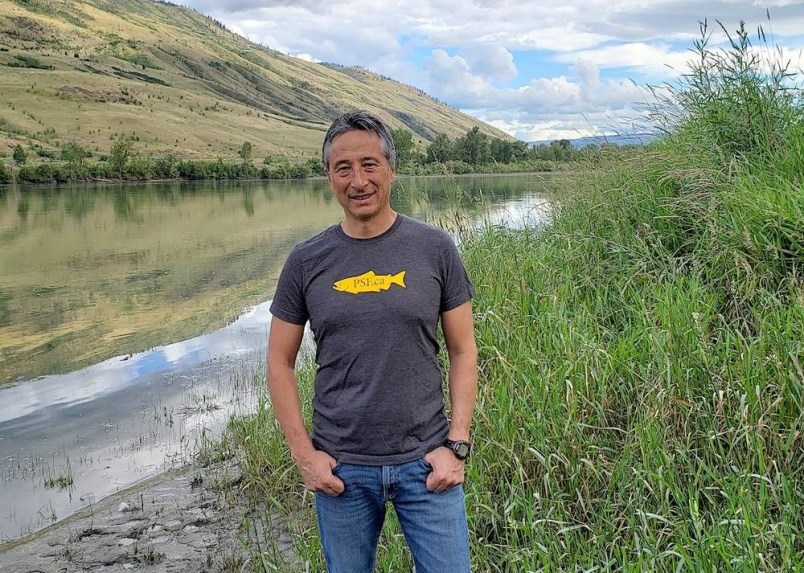Vancouver Island fish and forests are in greater peril than ever as the B.C. government issues widespread drought warnings after a record-breaking heat wave and an explosion of wildfires across the province.
Drought is impacting much of southern British Columbia and the central Interior due to very low rainfall, exacerbated by the recent extreme heat wave, according to the province.
Water scarcity and low stream flows are affecting Vancouver Island, the entire Thompson-Nicola region, the Cariboo, Shuswap, and the Okanagan.
Salmon and fish habitat is at greatest risk in streams and rivers on the eastern Island and the Salmon River watershed in the Shuswap.
Both areas are now at Drought Level 4, which means adverse impacts on fish are now very likely. Drought levels run from 0 to 5 — which is the most severe, with adverse socio-economic or ecosystem impacts being almost certain.
The cumulative effects of climate change witnessed across the province are hard on salmon — a keystone species in B.C. — said Jason Hwang, vice-president of the Pacific Salmon Foundation.
The recent heat dome, forest fires, and now drought threaten the ecosystems and watersheds that wild salmon need to survive, he said.
It’s obvious salmon need water, Hwang said, but extended droughts have outsized effects on their survival.
“We’ll probably see significant impacts on two generations of salmon,” he said.
Low, warm water levels impact juvenile salmon that spend the first year of life in streams and rivers before heading to the ocean.
“As water levels recede, they get trapped in little pockets of water,” Hwang said, adding they can die of heat or become vulnerable to predators.
And should the drought carry into late summer and fall, low flow levels mean returning adult salmon can’t head upstream, or remaining water is too hot, causing them to die without spawning.
The drought warnings come as B.C. continues to battle 306 active fires, with 27 blazes sparked in the past two days.
The fire danger ratings across Vancouver Island and southern B.C. are extreme or high, said Lori Daniels, a wildfire expert at the University of British Columbia.
Temperatures have been hot enough and drought persistent enough that burnable organic material is highly likely to ignite, she said.
“If you add a little bit of wind in there, we have a pretty toxic combination,” Daniels said, adding that the fire season is between three weeks and a month early in some areas.
The continuing warm weather is exacerbating the risk, she added. “And, quite frankly, I think it’s going to get worse before it gets better this month.”
Environment Canada meteorologist Bobby Sekhon said spring precipitation levels across the southern part of the province were lower than usual.
“On eastern Vancouver Island, the spring was quite dry,” he said.
Nanaimo had its fourth-driest spring on record, Sekhon said. “We saw anywhere from … 32 to 68 per cent of the average precipitation that we normally see in the months of March, April and May.”
The drought reflects the trend of climate change in B.C., which will likely result in more extremes and prolonged periods of dry weather in the summer and wet weather in the winter, he added.
Neither scenario is great for salmon because torrents of rain and rapid snow melt can cause floods and erode salmon habitat, wash away eggs or make rivers impassable for salmon, Hwang said.
Many of the smaller salmon streams and rivers on the eastern Island — which typically experience lower water levels than some other watersheds — rely on glacial melt to maintain flow during the summer.
But climate change is limiting the development of snow packs and glaciers, and extreme heat can melt them earlier and faster, leaving little to boost streams in late summer.
Currently, Sandhill Creek, Koksilah River, Chemainus River, Millstone River, Tsolum River, Black Creek, Fulford Creek on Salt Spring Island, and most of the Gulf Islands are experiencing critical shortages and lethal water temperatures and impacts to aquatic habitat.
Regulatory measures to conserve water are being considered, according to the provincial drought information portal. B.C. is urging residential, agricultural and industrial water users to employ aggressive conservation measures and to follow restrictions and advice from local governments.
Beyond being water-wise, individuals and communities can help salmon by protecting or restoring stream-side vegetation that can help with water quality and temperatures and by being careful not to dump anything toxic down storm drains, Hwang said.
The foundation is also working to encourage government and industrial sectors to optimize water-use systems, improve monitoring around water extraction, and co-ordinate withdrawals by heavy users, Hwang said.
Both individuals and large entities can make significant differences to mitigate and prevent drought, he added.
“We need to think about everything we could do this year, but even more importantly, what we do moving forward to reduce those pressures on water.”
— National Observer



